8 Easy Facts About Johannesburg North Attractions Explained
8 Easy Facts About Johannesburg North Attractions Explained
Blog Article
What Does Johannesburg North Attractions Mean?
Table of ContentsJohannesburg North Attractions - QuestionsJohannesburg North Attractions Fundamentals ExplainedLittle Known Facts About Johannesburg North Attractions.A Biased View of Johannesburg North Attractions7 Easy Facts About Johannesburg North Attractions ShownExamine This Report on Johannesburg North Attractions
The city owes its place to the existence of an even more valuable resource: gold. The city expanded on the edge of the Witwatersrand Main Coral reef, a subterranean stratum of gold-bearing quartz-silica corporation that arcs for numerous miles under the Highveld. A lot of the gold mines in the city stopped procedure in the 1970s, yet in its day the Witwatersrand gold industry accounted for greater than 40 percent of the world's annual gold manufacturing.Johannesburg has a temperate environment. Summer temperature levels balance about 75 F (24 C); winter season temperatures balance concerning 55 F (13 C) and just sometimes dip below cold. The city appreciates about eight hours of sunlight each day in both winter and summer season. Rain averages concerning 28 inches (700 millimetres) per year, however the overall varies considerably from year to year.
What rain the city receives falls practically specifically in the summertime, often in spectacular late-afternoon electric storms. Air pollution poses a significant issue, specifically in the cold weather, when thermal inversions impede the westward circulation of air from the Indian Sea. Contamination is most severe in the largely worked out Black areas on the city's periphery, where several citizens still depend on coal for fuel.

The Johannesburg North Attractions PDFs
The balance of the city is occupied by whites. Lodging varies in personality and high quality.
Physical growth, although rather restricted by transportation, proceeded swiftly as immigration to South Africa, and Johannesburg specifically, increased substantially. This trouble was solved in the 1930s when the automobile was presented in mass production to South Africa. Autos were, generally, constrained to the wealthy, and permitted them to move to the north of the city and commute into the centre.
The majority of bad residential areas were blended, with inadequate blacks and whites cohabiting, although the wealthy residential areas were generally booked for whites. This transformed with the political election of the National Celebration in the 1948 political elections, who began to formalise the system known as apartheid. Discrimination officially designated which suburbs each race can stay in under the Team Locations Act.
The previous system of web link eleven phoned number regions was reorganised in 2006. Marshalltown, as seen from the top of the Carlton Centre. The M1 and M2 run behind the structures, and the southern residential areas expand past the freeway border. find out this here The central city of Johannesburg is located within the city's Area F. The estimated population of the area is 200,000, [] The number of people living in the inner city on an informal basis is unidentified, as lots of are prohibited immigrants. The majority of higher-income homeowners and white people have transferred to the northern suburban areas and have actually been replaced by lower-income black people. The joblessness, education and learning, and age profiles of the area are all unidentified, as a result of the trouble of obtaining trusted information concerning the area.
The Only Guide to Johannesburg North Attractions
Yeoville and Bellevue have a mix of apartment and solitary residential systems on little whole lots. The area lies on a hilly divide that runs from east to west. The most conspicuous geographic feature is Observatory Ridge, which is called for the large observatory located on it. The entertainment rooms are no more used, because of protection troubles.

Excitement About Johannesburg North Attractions
R. Tambo International Airport Terminal). The eastern residential areas are a few of the earliest areas of Johannesburg, there are big areas of Jewish and other European histories, the majority of the population is English speaking. There are 3 golf programs in addition to a number of safeguarded ridges with important source viewsites. There are numerous strong and up-market enjoyment and purchasing areas in the eastern such as the Eastgate Shopping Centre and the Greenstone shopping centre.
Initially developed to house male migrant workers, many have actually been boosted as homes for couples and families. The suburban area was not traditionally enabled to produce employment centres within the area, so almost all of its homeowners are travelers to various other components of the city.
The Johannesburg North Attractions Diaries
The residential areas in the north residential areas are mainly formal, with no significant locations of casual housing, or housing that lacks a permanent structure. This is a well-known location, there is a trend of land usage modification from residential to business, specifically along main arterial roads and around recognized nodes.
The area is well linked to road networks, specifically along the north-south axis developed by the M1 and N1. Roads to the east and west are less well developed, as there are no highways travelling because instructions. Towards the northern boundary of the city, the thickness of growth lowers, leaving huge locations of untaught land around Midrand.
The Single Strategy To Use For Johannesburg North Attractions
, which is located on a hill overlooking the inner city and Hillbrow.
Report this page